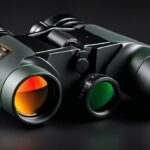Last Updated on 5 months by Francis
Foxes are known for their exceptional hunting abilities, but how well can they see in the dark? While there is limited empirical research on the sensory biology of foxes, especially their visual capabilities, observations suggest that they have good visual acuity at short range and are highly sensitive to movement. The type of cells predominant on the retina may limit their ability to hunt small, stationary objects. However, foxes possess several adaptations that enhance their vision, such as vertically slit pupils that help regulate the amount of light entering the eye and improve focus on lateral movement. They also have a tapetum lucidum, a layer of reflective cells behind the retina, which enhances their night vision and causes the familiar eye shine often observed in nocturnal animals.
Contents
Key Takeaways:
- Red foxes have good visual acuity at short range and are highly sensitive to movement.
- They possess adaptations such as vertically slit pupils and a tapetum lucidum that enhance their vision.
- The type of cells on their retina may limit their ability to hunt small, stationary objects.
- Red foxes are well-equipped for hunting in low light conditions.
- Further research is needed to fully understand their visual perception.
The Visual System of Red Foxes

Foxes have a unique visual system that allows them to adapt to various light conditions. Their vertically slit pupils, unlike the round pupils of most canids, allow them to regulate the amount of light entering their eyes more precisely. This adaptation enables them to hunt effectively in different light conditions. Foxes also possess a tapetum lucidum, which reflects light back into their eyes, enhancing their night vision. The eyes of red foxes exhibit a vertically-slit pupil, similar to that seen in many cat species, allowing for precise light regulation and improved vision in various lighting conditions.
Red foxes’ visual system, including their unique pupil shape and the presence of a tapetum lucidum, contributes to their exceptional hunting abilities. These adaptations enhance their visual perception and allow them to effectively navigate their environment, regardless of the lighting conditions. By regulating the amount of light entering their eyes, red foxes can optimize their visual acuity and focus on detecting movement, a crucial skill for successful hunting. The tapetum lucidum, a reflective layer of cells, amplifies available light and enhances night vision, providing red foxes with an advantage in low-light conditions.
The Role of Vertical Slit Pupils
The vertically slit pupils of red foxes play a significant role in their visual perception. Unlike round pupils, which are common in many mammals, the vertically slit pupils allow red foxes to control the amount of light entering their eyes more precisely. This adaptation enables them to adapt to varying light conditions, from bright daylight to dim twilight or nighttime. By adjusting the size of their pupils, red foxes can optimize their vision and ensure that their retinas receive the appropriate amount of light for clear and accurate visual perception.
| Visual Adaptation | Description |
|---|---|
| Vertically Slit Pupils | Regulate the amount of light entering the eyes, allowing for better adaptation to different light conditions. |
| Tapetum Lucidum | A reflective layer behind the retina that enhances night vision by reflecting light back onto the retinal cells. |
Red foxes possess an array of sensory adaptations that contribute to their successful hunting strategies. Their unique visual system, characterized by vertically slit pupils and a tapetum lucidum, allows them to thrive in diverse lighting conditions. These adaptations enable red foxes to effectively detect movement and enhance their night vision, giving them a competitive advantage in their ecological niches. The visual perception of red foxes is just one aspect of their complex sensory abilities, which also include acute hearing and a highly developed sense of smell.
The Role of Color Vision in Red Foxes
While there is limited research on the color vision of red foxes specifically, it is believed that they have dichromatic vision, similar to many mammals. This means that they likely perceive the world in shades of blue and green, without the ability to distinguish between other colors. The specific color perception of red foxes has not been extensively studied, but it is thought to play a limited role in their hunting and overall visual perception.
The adaptation of dichromatic vision in red foxes may be advantageous for their natural environment, allowing them to better blend in with their surroundings. This could provide camouflage when hunting or avoiding predators. However, it’s important to note that color vision is just one aspect of their overall visual perception, and red foxes rely on other sensory cues, such as movement and contrast, to navigate their environment and locate prey.
Further research is needed to gain a deeper understanding of the color vision of red foxes and its role in their visual perception. Investigating their specific color perception abilities and how it relates to their hunting strategies and survival in different habitats could provide valuable insights into the sensory adaptations of this fascinating species.
Table: Summary of Red Fox Color Vision
| Aspect | Summary |
|---|---|
| Color Perception | Dichromatic vision, perceiving shades of blue and green |
| Role in Hunting | Likely limited, as red foxes rely on other sensory cues for prey detection |
| Possible Advantage | Enhanced camouflage abilities in their natural environment |
| Research Gap | Further study needed to uncover specific color perception abilities and their significance |
Sensitivity to Infrared Light in Red Foxes
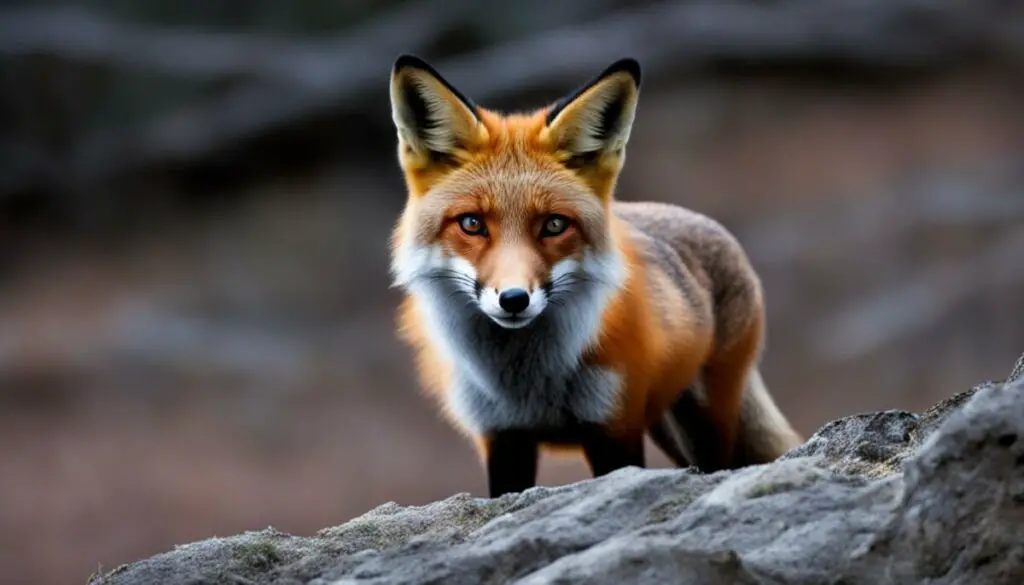
While red foxes possess remarkable visual adaptations for hunting, their sensitivity to infrared light is limited. The rod cells in their retinas, which are responsible for detecting low levels of light, primarily respond to blue/purple light and are not sensitive to infrared wavelengths. This means that red foxes are unlikely to see infrared light in the same way that thermal imaging devices can.
Research specifically focused on the ability of red foxes to perceive infrared light is scarce, but their visual system provides valuable insights. The vertically slit pupils and tapetum lucidum in their eyes enhance their night vision and ability to detect movement, but these adaptations are not specialized for perceiving infrared light.
While red foxes may not have the ability to see infrared light, they possess a range of other sensory adaptations that enable them to hunt effectively. Their acute hearing and sense of smell, combined with their exceptional visual acuity and night vision, make them highly efficient nocturnal hunters.
Table: Comparing Sensitivity to Infrared Light in Different Animal Species
| Species | Infrared Perception |
|---|---|
| Thermal Imaging Devices | High sensitivity to infrared light for thermal detection |
| Snakes and Pit Vipers | Specialized heat-sensing organs for thermal detection |
| Red Foxes | Limited sensitivity to infrared light; visual adaptations enhance night vision |
The table above provides a comparison of the sensitivity to infrared light in different animal species. While red foxes may not have the same infrared perception as thermal imaging devices or species with specialized heat-sensing organs, their exceptional visual adaptations allow them to thrive in low light conditions.
The image above depicts a red fox, showcasing its unique visual adaptations and natural habitat.
Adaptations for Nocturnal Hunting

Red foxes have evolved several adaptations that enhance their ability to hunt and navigate in the dark. Their survival depends on their exceptional night vision and sensory abilities, which allow them to locate and capture prey effectively. These adaptations include:
- Large Eyes: Red foxes have relatively large eyes compared to their body size, enabling them to gather more light and enhance their visual acuity in dimly lit conditions.
- Vertically Slit Pupils: The vertically slit pupils of red foxes allow them to regulate the amount of light entering their eyes, optimizing their vision in different lighting conditions. This adaptation helps them maintain clear focus on horizontal movements, such as those made by small ground-based prey.
- Tapetum Lucidum: Red foxes possess a tapetum lucidum, a reflective layer behind their retinas. This layer enhances their night vision by reflecting light back onto the retina, effectively improving their sensitivity to low light levels.
These adaptations work together to give red foxes a competitive advantage when hunting at night. Their visual acuity, combined with their acute sense of hearing and keen sense of smell, allows them to locate and pursue prey with remarkable efficiency.
Table: Comparative Night Vision Adaptations in Select Animal Species
| Species | Adaptations for Night Vision |
|---|---|
| Red Fox | Large eyes, vertically slit pupils, tapetum lucidum |
| Owl | Large eyes, binocular vision, specialized feathers for silent flight |
| Cat | Nocturnal retina, large eyes, tapetum lucidum |
| Bat | Echolocation, large ears, specialized vision for low light conditions |
Table notes: The table provides a comparison of night vision adaptations in select animal species. Each species has unique adaptations that contribute to their ability to see and navigate in the dark. While red foxes rely on their large eyes, vertically slit pupils, and tapetum lucidum, other species have their own remarkable adaptations suited for their nocturnal lifestyles.
Comparison to Other Species
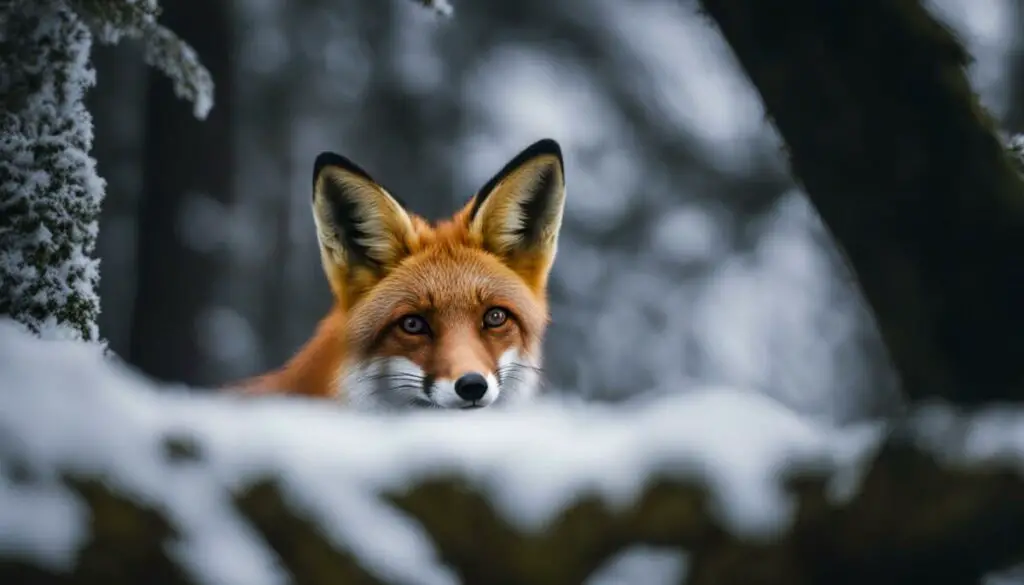
While red foxes may not have the same sensitivity to infrared light as thermal imaging devices, they possess other sensory abilities that help them detect prey. In comparison to some other species, such as snakes and pit vipers, which have specialized heat-sensing organs for thermal detection, red foxes rely on their visual acuity, hearing, and sense of smell to locate and capture their prey. These adaptations, along with their agile and quick movements, make them successful hunters in their natural habitats.
| Red Foxes | Snakes | Pit Vipers | |
|---|---|---|---|
| Heat Sensing | No specialized heat-sensing organs | Specialized heat-sensing organs (pit organs) | Specialized heat-sensing organs (pit organs) |
| Thermal Detection | Rely on visual acuity, hearing, and sense of smell | Can detect heat signatures from prey | Can detect heat signatures from prey |
| Movements | Agile and quick movements | Slithers | Slithers |
| Other Sensory Abilities | Keen senses of hearing and smell | Keen senses of smell and vibration detection | Keen senses of smell and vibration detection |
As shown in the table above, red foxes rely on a combination of visual acuity, hearing, and sense of smell to locate and capture prey. While they do not possess specialized heat-sensing organs like snakes and pit vipers, they make up for it with their agility and quick movements, allowing them to efficiently hunt in their natural habitats.
It’s important to note that different species have evolved unique strategies for survival and prey detection. While some animals, like red foxes, rely on a combination of senses to locate prey, others have specialized organs to detect heat signatures. Understanding these adaptations across species provides valuable insights into the diverse ways animals navigate their environments and secure food sources.
Key Takeaways:
- Red foxes do not have specialized heat-sensing organs like snakes and pit vipers.
- They rely on visual acuity, hearing, and sense of smell to detect prey.
- Red foxes exhibit agile and quick movements, aiding in their hunting success.
- Other species, such as snakes and pit vipers, use specialized heat-sensing organs to detect thermal signatures.
- Understanding the diverse adaptations of different species enriches our knowledge of animal behavior and survival strategies.
Camera Trapping and Visual Perception Studies
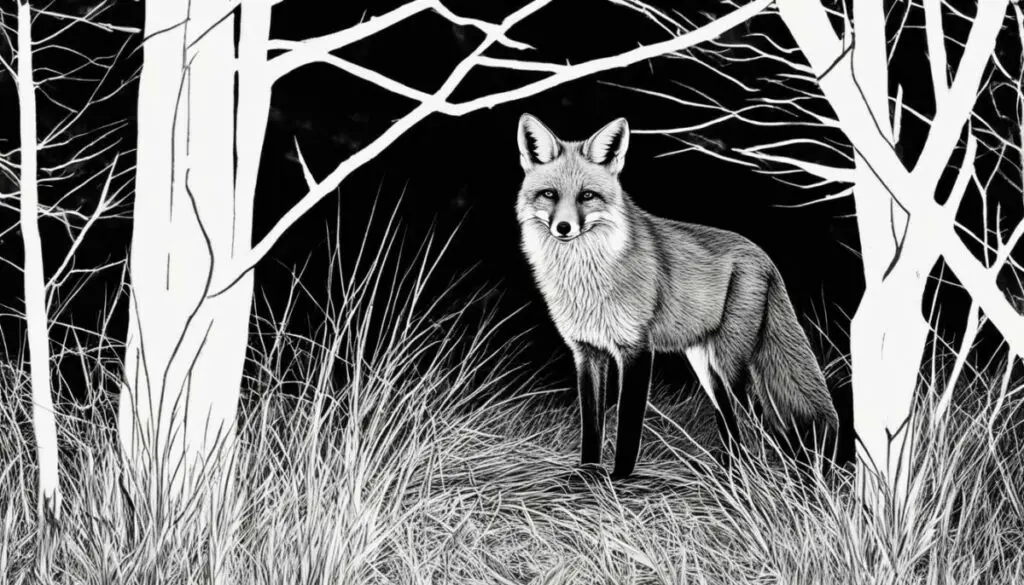
Camera trapping has proven to be a valuable tool in wildlife research, providing insights into the behavior and ecology of various species. While camera traps have been widely used to study red foxes, there is limited specific research on their visual perception using these techniques.
Most camera trap studies involving red foxes primarily focus on population estimates, behavior observations, and individual identification. While these studies contribute to our understanding of the species, they do not directly investigate the visual capabilities and sensory adaptations of red foxes.
To gain a more comprehensive understanding of red foxes’ visual perception, future research could utilize camera trapping techniques specifically designed to assess their visual acuity, color vision, and sensitivity to different light conditions. By incorporating visual stimuli and observing the behavioral responses of red foxes, researchers could gather valuable data on their visual perception and the role it plays in their hunting strategies and overall survival.
“Camera trapping has been a valuable tool for studying the behavior and ecology of red foxes, but more research is needed to understand their visual perception and sensory adaptations.” – Wildlife Researcher
The Potential of Visual Perception Studies
Visual perception studies in red foxes have the potential to unlock fascinating insights into how they navigate their environment and locate prey. By analyzing the response of red foxes to visual stimuli, researchers can determine the range of light wavelengths they perceive, their ability to detect contrasts and movement, and how these factors influence their hunting success.
Additionally, visual perception studies can shed light on the adaptability of red foxes to different habitats and environmental conditions. By comparing populations in different regions or with varying ecological pressures, researchers can gain a deeper understanding of how visual perception influences the survival and behavior of red foxes.
The Role of Camera Trapping
Camera trapping, when combined with carefully designed experiments and stimuli, can provide valuable data on red foxes’ visual perception. By strategically placing camera traps in different environments and using controlled visual stimuli, researchers can observe and analyze the behavioral responses of red foxes in real-world scenarios.
These studies can help identify the specific visual cues that red foxes rely on for hunting and survival, providing important insights for wildlife conservation and management efforts. Understanding the visual perception of red foxes can inform the development of conservation strategies that preserve their natural habitats and promote coexistence with human populations.
The Importance of Visual Perception in Red Foxes
Visual perception plays a crucial role in the hunting behavior and survival of red foxes. Their ability to see and interpret visual cues, such as movement and contrasts, allows them to locate and pursue prey effectively. The unique adaptations of their visual system, including the vertically slit pupils and tapetum lucidum, enhance their night vision and provide them with a competitive advantage in low light conditions. However, it is important to note that the visual perception of red foxes is just one aspect of their complex sensory abilities, which also include acute hearing and a highly developed sense of smell.
Red foxes possess several adaptations that enhance their ability to hunt at night. Their large eyes and vertically slit pupils allow for better light-gathering capabilities and improved focus on horizontal movement, which is useful for detecting small ground-based prey. The tapetum lucidum in their eyes reflects light back onto the retina, increasing the sensitivity of their vision in low light conditions. These adaptations, combined with their keen sense of hearing and acute sense of smell, make red foxes highly efficient nocturnal hunters.
While red foxes may not have the same sensitivity to infrared light as thermal imaging devices, they possess other sensory abilities that help them detect prey. In comparison to some other species, such as snakes and pit vipers, which have specialized heat-sensing organs for thermal detection, red foxes rely on their visual acuity, hearing, and sense of smell to locate and capture their prey. These adaptations, along with their agile and quick movements, make them successful hunters in their natural habitats.
| Red Foxes | Snakes | Pit Vipers | |
|---|---|---|---|
| Visual Acuity | Highly developed | Varying, but generally lower than red foxes | Varies among species, but generally lower than red foxes |
| Heat Sensing | Relies on visual cues, hearing, and smell | Specialized heat-sensing organs | Specialized heat-sensing pits |
| Nocturnal Hunting | Efficient and adapted for low light conditions | Adapted for low light conditions | Adapted for low light conditions |
“Red foxes possess several adaptations that enhance their ability to hunt at night, including their visual acuity, keen hearing, and acute sense of smell.”
Future Research and Implications
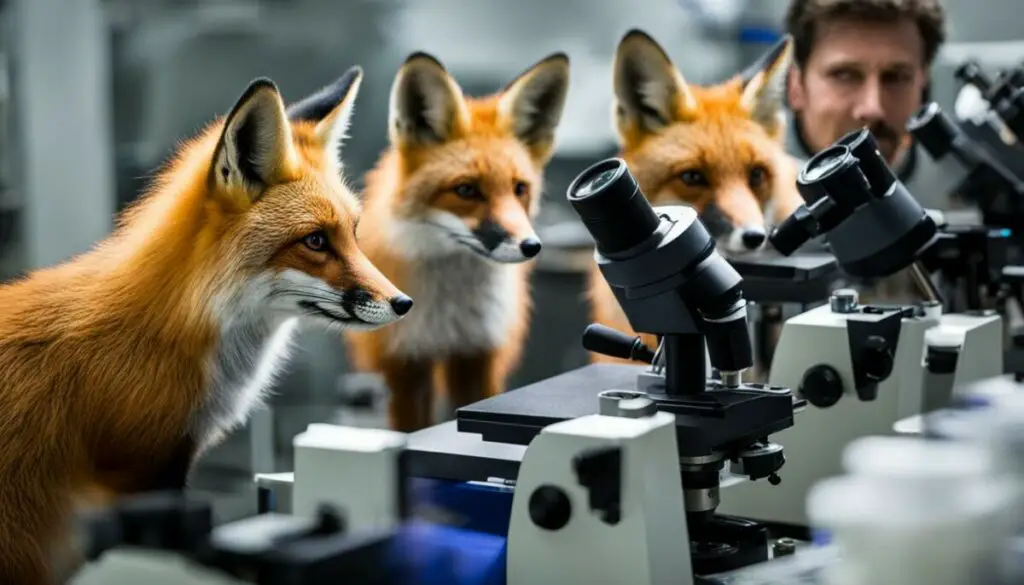
The sensory abilities of red foxes continue to intrigue researchers, and further studies are needed to deepen our understanding of their visual perception and other adaptations. Investigating the color vision, fine details of their retinal structure, and the specific role of the tapetum lucidum in enhancing their night vision can provide valuable insights into their hunting strategies and survival in different environments.
Future research could also focus on comparing the visual perception of red foxes to other nocturnal predators to gain a more comprehensive understanding of their sensory capabilities. By studying the visual systems of various species, researchers can identify common mechanisms and adaptations across different taxa and shed light on the evolutionary processes that have shaped their visual perception.
Understanding the sensory abilities of red foxes also has implications for wildlife conservation and management. By recognizing their unique adaptations, conservationists and wildlife managers can develop effective strategies to mitigate human-wildlife conflicts and protect vulnerable populations. Additionally, understanding how red foxes perceive and navigate their environment can inform the design of non-lethal deterrents and management practices that are specific to their sensory abilities.
Overall, future research on red foxes’ sensory abilities holds promise for revealing fascinating insights into their visual perception and contributing to their conservation and management. By unraveling the mysteries of these adaptations, we can foster a greater appreciation for the remarkable sensory world of red foxes and work towards their coexistence with human communities.
| Research Areas | Implications |
|---|---|
| Color vision and retinal structure | Understanding how red foxes perceive colors can provide insights into their ecological roles and hunting strategies. |
| Comparative studies with other predators | Comparing the visual systems of red foxes to those of other nocturnal predators can reveal common adaptations and evolutionary patterns. |
| Conservation and wildlife management | By considering red foxes’ sensory abilities, conservationists can develop effective strategies to minimize conflicts and protect vulnerable populations. |
| Non-lethal deterrents | Insights into red foxes’ sensory perception can inform the development of non-lethal methods to deter them from human settlements. |
Conservation and Wildlife Management
Conservation and effective wildlife management strategies are essential for the protection and preservation of red fox populations. Understanding the sensory adaptations of these fascinating creatures is crucial when implementing conservation efforts. By considering their visual perception, hearing, and sense of smell, conservationists and wildlife managers can develop comprehensive strategies to mitigate human-wildlife conflicts, protect vulnerable populations, and promote coexistence.
Red foxes have unique sensory adaptations that enable them to thrive in their natural habitats. Their keen senses, including their acute hearing and sense of smell, help them navigate their environment and locate prey. These adaptations, combined with their visually impressive qualities, such as their vertically slit pupils and tapetum lucidum, enhance their hunting abilities and survival.
When managing red fox populations, it is crucial to recognize their sensory adaptations and integrate this knowledge into management plans. By understanding their behavior and sensory capabilities, wildlife managers can develop non-lethal deterrents, implement habitat management practices, and create protected areas that support the natural behaviors and survival of red foxes. This holistic approach ensures the long-term conservation of these beautiful creatures while also promoting the preservation of biodiversity and ecological balance within their ecosystems.
Table: Sensory Adaptations of Red Foxes
| Sensory Ability | Adaptations |
|---|---|
| Visual Perception | – Vertically slit pupils for precise light regulation |
| – Tapetum lucidum for enhanced night vision | |
| Hearing | – Acute hearing for detecting prey and avoiding predators |
| Sense of Smell | – Highly developed sense of smell for locating prey and marking territories |
Understanding and appreciating the sensory adaptations of red foxes is crucial for their conservation and effective wildlife management. By incorporating this knowledge into conservation strategies and habitat management plans, we can ensure the long-term survival of red fox populations and maintain the delicate balance of our natural ecosystems.
Conclusion
In conclusion, the red fox possesses remarkable sensory adaptations that contribute to their hunting abilities and overall survival. While more research is needed to fully understand their visual perception, it is evident that their unique visual system, including features like vertically slit pupils and a tapetum lucidum, enhances their night vision and enables them to detect movement effectively.
These adaptations, along with their acute hearing and sense of smell, make red foxes highly efficient hunters in both daylight and low-light conditions. Studying the sensory abilities of red foxes not only aids in our understanding of these fascinating creatures but also has implications for wildlife conservation and management efforts.
By considering the sensory adaptations of red foxes, wildlife managers and conservationists can develop strategies to mitigate human-wildlife conflicts, protect vulnerable populations, and promote coexistence. This knowledge can also contribute to the development of non-lethal deterrents and management practices that take into account the unique sensory abilities of red foxes and other wildlife species.
In summary, the sensory adaptations of red foxes, including their visual system, hearing, and sense of smell, play a vital role in their hunting prowess and survival. Further research in this field will not only expand our knowledge of these fascinating creatures but also inform conservation efforts and help ensure their continued existence in our changing world.
FAQ
Can red foxes see infrared light?
Although there is no specific research on whether red foxes can see infrared light, their visual system suggests that they may have limited sensitivity to this part of the light spectrum. The rod cells in their retinas, which are responsible for detecting low levels of light, primarily respond to blue/purple light and are not sensitive to infrared wavelengths. Therefore, it is unlikely that red foxes can see infrared light in the same way that thermal imaging devices can.
What adaptations do red foxes have for hunting at night?
Red foxes possess several adaptations that enhance their ability to hunt at night. Their large eyes and vertically slit pupils allow for better light-gathering capabilities and improved focus on horizontal movement, which is useful for detecting small ground-based prey. The tapetum lucidum in their eyes reflects light back onto the retina, increasing the sensitivity of their vision in low light conditions. These adaptations, combined with their keen sense of hearing and acute sense of smell, make red foxes highly efficient nocturnal hunters.
How do red foxes compare to other species in terms of infrared detection?
In comparison to some other species, such as snakes and pit vipers, which have specialized heat-sensing organs for thermal detection, red foxes rely on their visual acuity, hearing, and sense of smell to locate and capture their prey. These adaptations, along with their agile and quick movements, make them successful hunters in their natural habitats.
Is there research on the visual perception of red foxes using camera trapping techniques?
Although camera trapping has been widely used in wildlife research, there is limited specific research on the visual perception of red foxes using this technique. Most studies involving camera traps focus on population estimates, behavior observations, and individual identification, rather than investigating the visual perception of the animals being studied. More research is needed to better understand the visual capabilities and sensory adaptations of red foxes.
What is the importance of visual perception in red foxes?
Visual perception plays a crucial role in the hunting behavior and survival of red foxes. Their ability to see and interpret visual cues, such as movement and contrasts, allows them to locate and pursue prey effectively. The unique adaptations of their visual system, including the vertically slit pupils and tapetum lucidum, enhance their night vision and provide them with a competitive advantage in low light conditions. However, it is important to note that the visual perception of red foxes is just one aspect of their complex sensory abilities, which also include acute hearing and a highly developed sense of smell.
What are the future research and implications regarding red foxes’ sensory abilities?
Our current understanding of the sensory abilities of red foxes is based on behavioral observations and extrapolations from similar species. Further research is needed to provide a more comprehensive understanding of their visual perception and other sensory adaptations. Studying the visual system of red foxes can provide valuable insights into their hunting strategies, ecological roles, and overall survival in changing environments. This knowledge can also have implications for wildlife conservation and management efforts, as understanding the sensory abilities of various species helps inform conservation strategies and habitat management plans.
How do red foxes contribute to wildlife management and conservation?
Understanding the sensory adaptations and capabilities of red foxes can be important for wildlife management and conservation efforts. By considering their visual perception, hearing, and sense of smell, conservationists and wildlife managers can design effective strategies to mitigate human-wildlife conflicts, protect vulnerable populations, and promote coexistence. This knowledge can also inform the development of non-lethal deterrents and management practices that take into account the unique sensory abilities of red foxes and other wildlife species.




